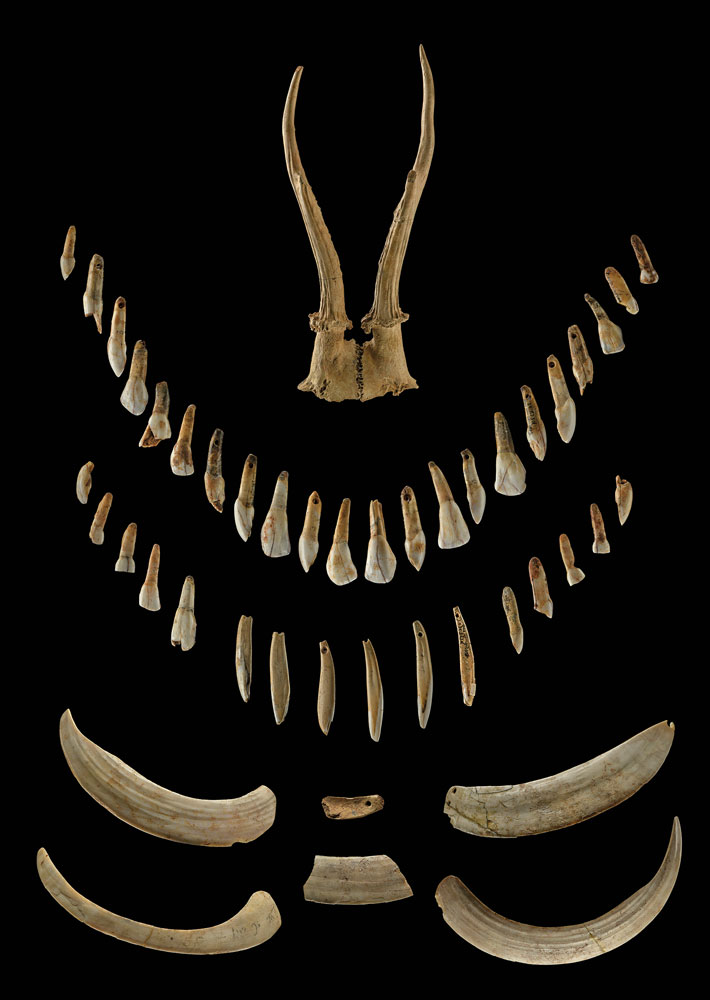9,000 years ago, two people were buried in Germany with hundreds of ritual objects—who were they?
Bad Durrenberg is a modest spa town in eastern Germany, perched on a bluff overlooking the Saale River. On a Friday afternoon in 1934, workers were laying pipe to supply the spa’s fountain with water when they came across red-tinted earth. A local teacher was quickly called to come to the trench. He began to dig and alerted an archaeologist named Wilhelm Henning based in the nearby city of Halle. By the time Henning arrived, the teacher had uncovered flint blades, mussel shells, roe deer remains, and wild boar tusks.
Given just a few hours to work before the trench had to be filled in, Henning salvaged what he could, pulling human bones from the earth and trying to recover as many as possible. A rough sketch made during the dig, now in the archives of the State Museum of Prehistory in Halle, shows a skeleton placed as if seated in a shallow pit, along with the approximate location and outlines of the original ditch.
Among the finds that emerged from the grave that afternoon was a second, tiny skull belonging to an infant of less than a year old, found between the thighs of the adult burial. Other unusual items included the delicate antlers of a roe deer, still attached to part of the skull, that could have been worn as a headdress. Henning also unearthed a polished stone ax similar to a type known from other sites in the area and 31 microliths, small flint blades barely an inch long. These artifacts led archaeologists to conclude that the grave belonged to a Neolithic farmer. Their opinion would later turn out to be entirely wrong—the first, but far from the last, time that archaeologists’ interpretation of the skeleton’s identity was mistaken.
Germany Mesolithic Shaman Map(Ken Feisel)The ideology of 1930s Germany helped shape scholars’ initial interpretation of the grave. Discovered barely a year and a half after the Nazis took power, politics quickly became enmeshed in the skeleton’s story. Archaeologists were a fundamental part of Adolf Hitler’s nation-building program, which sought to locate physical evidence of the original Aryans, who the Nazis believed were blond-haired and blue-eyed and came from northern Europe. Hoping to support this idea, another archaeologist on the scene—who was a member of the Amt Rosenberg, a cultural policy and surveillance body within the Nazi party—proclaimed the grave that of an ur-Aryan based on the presence of the single stone ax and microliths. “The Nazis thought the burial belonged to a white man from the Neolithic,” says Harald Meller, director of the State Museum of Prehistory, an erroneous and dangerous conclusion that was part of a larger campaign to prove that the German “race” had been in northern Europe for thousands of years.
Over the decades, generations of scholars would revisit the Bad Dürrenberg remains in the museum and advance new theories. In the 1950s, researchers reexamined the skeleton and, based on the shape of the pelvis and other bones, suggested that they belonged to a woman. The copious grave goods—in addition to the antler headdress, blades, mussel shells, and boar tusks there were hundreds of other artifacts, including boars’ teeth, turtle shells, and bird bones—clearly marked the burial as special. The flints and other finds were firmly rooted in the world of Mesolithic hunter-gatherers who lived between 12,000 and 6,000 years ago, rather than the more agrarian Neolithic farmers in the following period. That dating, too, deepened the mystery. The few Mesolithic graves that had been unearthed in Europe contained a flint blade or two, at most. In comparison, the Bad Dürrenberg grave was uniquely rich for the period.
Hits: 20










